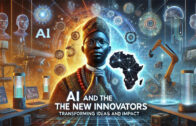AI -The New Brain of Engineering and Innovation
MEMBERS & VISITORS:
AI: The New Brain of Engineering and Innovation
“AI in engineering problem solving”
AI: The New Brain of Engineering and Innovation.
Download the ebook “AI -The New Brain of Engineering and Innovation”
So, AI can now solve complex engineering problems in seconds, leaving students and professionals wondering, “What do we even do anymore?” With artificial intelligence speeding up tasks that once took hours of manual labor, it’s like the calculator revolution, but on steroids. In case you missed the memo, this leap forward is reshaping not only how we teach and learn but how we approach invention, innovation, problem solving, and even broad disciplines like engineering as a whole.
When calculators hit the classroom, teachers shifted away from teaching students how to calculate long division by hand. The focus turned toward understanding the big picture—like what the calculations meant, not how to do them. Fast forward to today, and AI is pulling off a similar magic trick. Now, it’s taking over the grunt work of design simulations and optimizations, leaving us humans to deal with the juicy stuff like creativity and conceptual thinking.
I had accessed and displayed the image containing problems 11 to 15 from an engineering statics text book. AI proceeded to solve each of the problems presented on the page, quickly and correctly. This is the set of problems AI was asked to solve.
Students: Hold On to Your Thinking Caps.
Once upon a time, students would be bogged down by technical problem-solving exercises, but AI’s got that covered now. Education is moving toward deeper questions, where you have to actually think (what a concept!) instead of just plugging numbers into formulas. Exams could soon look more like group therapy for ethical dilemmas, where your ability to think critically and creatively is tested rather than your ability to crunch numbers.
Engineers: Relax, But Not Too Much.
For engineers, the good news is that you no longer have to waste time on routine tasks. Just delegate that to your AI assistant. The bad news? You’ll have to put on your innovation hat and focus on solving complex problems that the bots can’t. Sure, AI might handle all the boring calculations, but it still can’t lead a meeting or charm a client—at least, not yet.
Laypeople: Welcome to the Big Leagues.
AI is not just for the pros anymore. Even people with no background in engineering can now fiddle with complex problems thanks to user-friendly AI tools. You could be sitting on your couch, solving problems that used to take experts years of training to understand. But, hey, don’t get cocky. The hard part isn’t always the math—it’s knowing when and how to use the answers the AI gives you.
The Digital Divide (A Real Party Pooper).
But before you start celebrating the utopia where AI does everything for us, consider this: access to AI is not equal. While some will be rubbing shoulders with cutting-edge tech, others might be left staring at a brick wall. Closing this gap will be a challenge, and we better get moving before the gap turns into a canyon.
So, what’s the takeaway? Sure, AI is speeding up engineering like never before, but don’t throw out your thinking cap just yet. Whether you’re a student, professional, or curious bystander, the name of the game is now creative problem-solving and big-picture thinking—and AI is just one more tool in that toolbox.
I have accessed and displayed the image containing problems 11 to 15. I will now proceed to solve each of the problems presented on the page.
Problem 2/11:
The two structural members exert forces on the joint O, one in tension and the other in compression. We are asked to find the magnitude of the resultant force
R can be found using vector addition:
Break the forces into x and y components.
Sum the components.
Calculate the magnitude of the resultant vector.
Find the angle of the resultant vector.
Let’s calculate this step by step:
.
We need to find the resultant force and the angle it makes with the positive y-axis. Using the same method as in Problem 2/11, we will break the forces into components, sum them, and calculate the magnitude and angle.
Problem 2/15:
A compressive force
𝐹
F is transmitted via a coupler arm to a disk. We are asked to develop expressions for the components of the force based on the angles and then calculate the force components for given conditions.
I will now proceed to calculate the results for each problem.
Problem 2/11 And 2/12 Results
I have provided the results for Problems 2/11 and 2/12 in a table format, which includes the following:
For Problem 2/11, the magnitude of the resultant force is approximately 4.84 kN, and the angle it makes with the positive x-axis is around 18.07 degrees.
For Problem 2/12, the required tension in cable AC is about 13.86 kN, and the downward force at point A is also 13.86 kN.
I will now proceed to solve the remaining problems (2/13, 2/14, and 2/15).
Problem 2/13 To 2/15 Results
I have provided the results for Problems 2/13 to 2/15 in a table format, including the following:
For Problem 2/13, the resultant force on the pulley is approximately 692.82 N.
For Problem 2/14, the resultant force exerted on the shrub is around 58.62 lb, and the angle it makes with the positive y-axis is approximately 60.38 degrees.
For Problem 2/15, the n- and t-components of the force.
F=800N, they are 565.7 N and 400 N respectively.
These results demonstrate how AI can rapidly solve complex engineering problems, offering valuable insights into how this capability could impact both educational and professional fields in the future. As this technology continues to evolve, it could significantly influence how we teach, learn, and apply engineering concepts, making them more accessible to a broader audience, even those without formal training.
Be sure to visit “Tharaka Invention Academy” where you can learn about how anybody can acquire the mindset, skills, and knowledge needed by all problem solvers, innovators, and inventors. The post entitled “Global Innovators: 101 Careers Transformed by Invention Skills” contains links to many more similar stories about these people worldwide.
Questions?? Contact me any time at profsinger@inventionschool.tech
We have published other informative posts on Invention School’s website which may interest you. To view our entire catalog of over 1000 posts go to inventionschool.tech/category/blog/ or use our handy search tool to find topics of interest to you.
Mechanical/Solar Engineer, Prof. Oku Singer
(41)




